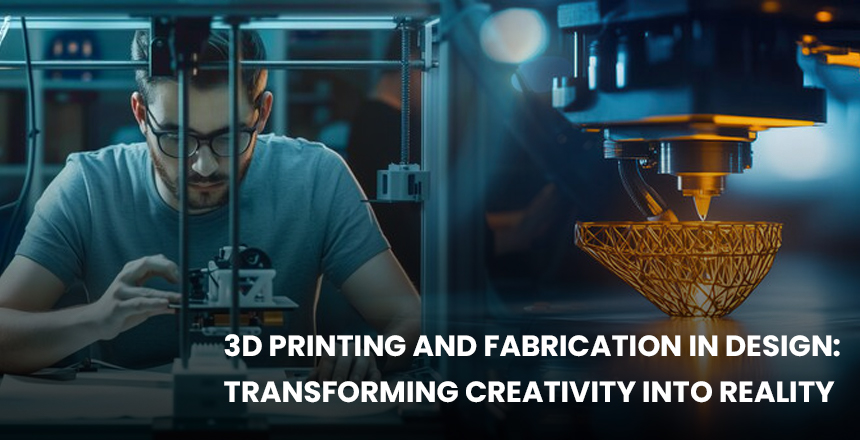3D printing and fabrication have made their entrance among the modes of modern design and
manufacturing as techniques that are totally different from the existing one. These methods of
production, which are new and revolutionizing, have completely changed the way people in
furniture, car, and machinery manufacture do their work with the help of computers. They even
provide such an opportunity that originally impossible tasks become not only possible but also
done faster and easier than ever before. The application of 3D printing and fabricating
processes is directly related to the achievement of the objectives in various industries.
What is 3D printing and fabrication?
Three-dimensional printing is a process of making objects with the help of a digital design file by
adding layers. The difference is that in the traditional subtractive manufacturing techniques,
where material is taken away to achieve a shape, 3D printing adds material, therefore it is
regarded as a more advanced and ecological process.
Fabrication is the term that describes the action of making the items or parts from the raw
materials. Adding 3D printing enables fabrication to be much more elaborate and creative with
designs and shapes that could not be realized before, in addition to the classic techniques like
cutting, welding, and casting.
How 3D Printing Works
Conception of Design:
The first step in this procedure is the construction of a digital 3D model through CAD
(Computer-aided Design) software. After completing the model, the designer will need to
transcribe it to a 3D printable file format such as STL (Standard Tessellation Language).
Slicing:
The slicing software transforms the computer-aided design (3D model) into a series of thin
horizontal layers, and produces instructions (G-code) for the printer to build the product.
Printing:
The printer will create the target object by working in an additive way, with various materials
which could include plastics, resins, metals, or ceramics. FDM (Fused Deposition Modeling),
SLA (Stereolithography), and SLS (Selective Laser Sintering) are the printing technologies used
for a different range and types of materials.
Post-Processing:
Once the object is printed, the eventual brush-and-spray, or else the assembly process is
performed to make it look and function the way it is desired.
3D Printing and Fabrication in Design Secure Applications
Prototype making:
The designers and engineers effectively make prototypes very quickly by 3D printing, making
it possible for them to test ideas, make changes, and find possible deficiencies before they
decide to start serial production.
The design of the product:
3D printing enables the manufacture of complex and unique designs, whereby, for example,
fashion, furniture, and electronic industries enable their creativity to walk on the dead end.
Architecture:
Use of 3D printing by architects for construction of miniature intricate models of buildings and
landscapes has greatly improved their visualization and communication with the clients.
Healthcare:
Prostheses and implants, as well as anatomical models intended for surgery pre-planning, are
some examples that 3D printing is making the medical field more efficient. The entirely
individualized treatment options are now available.
Aerospace and Automotive:
Lightweight components manufactured through 3D printing are the main focus of the two
sectors utilizing this technology, thus, the process is making huge strides in terms of less
environmental impact and fuel consumption. Rapid prototyping is one another 3D printing
benefit that aids faster product development.
Jewelry and Fashion:
3D printing paves the way for designers to create stunning and elaborate jewelry and
accessories with precise details, therefore, it is a new production tool and marketing weapon in
the world of fashion.
Education:
Educational institutions employ 3D printing as a hands-on teaching aid for imparting practical
knowledge in design, engineering, and STEM fields.
Advantages of 3D Printing and Fabrication
Speed and Efficiency:
Old-style manufacturing techniques could take too long, even several weeks, to produce a
prototype. In contrast, 3D printing can print and test designs in some hours only, which leads to
a huge reduction in the time spent on development.
Cost-Effective:
Due to the absence of complicated and costly molds and tools, 3D printing offers savings on
production costs, particularly in the case of small batches or customer designs.
Customization:
3D printing is one such technology that has the potential to customize products as it offers
high flexibility in the design process and so it is possible to make a totally unique product.
Complexity Without Extra Cost:
3D printing is a mode of manufacturing that is oppositely affected by the extent of complexity;
it can turn out very complicated shapes and designs without incurring extra costs.
Sustainability:
Additive manufacturing, as a more environmentally-friendly approach than subtractive
methods, takes less material waste.
On-Demand Manufacturing:
Products can be printed when necessary, which leads to a decreased need for large stocks on
hand and thus storage costs.
Problems of 3D Printing and Fabrication
Material Restrictions:
As much as the number of materials available for 3D printing is on the rise being far less than
the traditional production technique.
Cost of Equipment:
The cost of accessing high-quality 3D printers and materials limits the ability of small
businesses or individuals to explore their creativity beyond the box.
Resistance Concern:
A few 3D-printed items may not be as strong and durable as those made in traditional
production methods.
Intellectual Property Rights:
As it becomes easy to copy patterns, it consequently creates more concerns about the
infringement of the copyright law and the unauthorized replication of the products.
Expertise Guarantees:
To design for 3D printing, the user should be proficient in using CAD software and should have
knowledge about printing technologies, which might come at a cost to beginners.
Future Trends in 3D Printing and Fabrication
Bioprinting:
The example of how such essay topics can be made becomes clear through the Xerox
company and its numerous innovations in this area.
Multi-Material Printing:
As time progresses, more and more 3D printers will have the ability to use multiple materials at
once. Through this, it will be possible to manufacture products that are complex and therefore
have different characteristics.
Mass Customization:
The production of specific goods that customers order will be conducted on a larger scale.
This development will be a breakthrough in such sectors as apparel, medicine, and consumer
goods.
Integration with AI:
The machine learning applications will assist in constructing 3D printing projects such as
developing strategies, managing inventory, and estimating costs.
Eco-Friendly Materials:
Environmentally friendly printing will be possible through the use of materials such as
biodegradable plastics and recycled filaments.
3D Printing and Fabrication in Everyday Design
3D printing is now also in the field of everyday design, which is beyond industrial use. Creative
individuals and do-it-yourselfers are utilizing the inexpensive 3D printers for their works of art,
forming home interior items, some spare parts, and personalized accessories. Websites such as
Thingiverse and MyMiniFactory make available a huge number of 3D models online and in this
manner encourage people to realize as many of their inventions as possible.
Conclusion
3D printing and fabrication are the two most revolutionary means of design and manufacturing.
The technologies of these are the foundation of unlocking levels of creativity and efficiency that
would not be possible otherwise through rapid prototyping, customization, and sustainable
production. Even though there are some constraints, the progress in 3D printing is directly the
source for the optimistic future. The introduction of these innovative technologies will not only
change the existing ways of doing things in various sectors but also make it possible for the
common people to do them.
The exploration of this life-changing technological breakthrough is the only space where we can
go as far as our brains find. 3D printing and fabrication will be a very exciting way to turn your
ideas into a reality whether you are a designer or an engineer or even a hobbyist.








